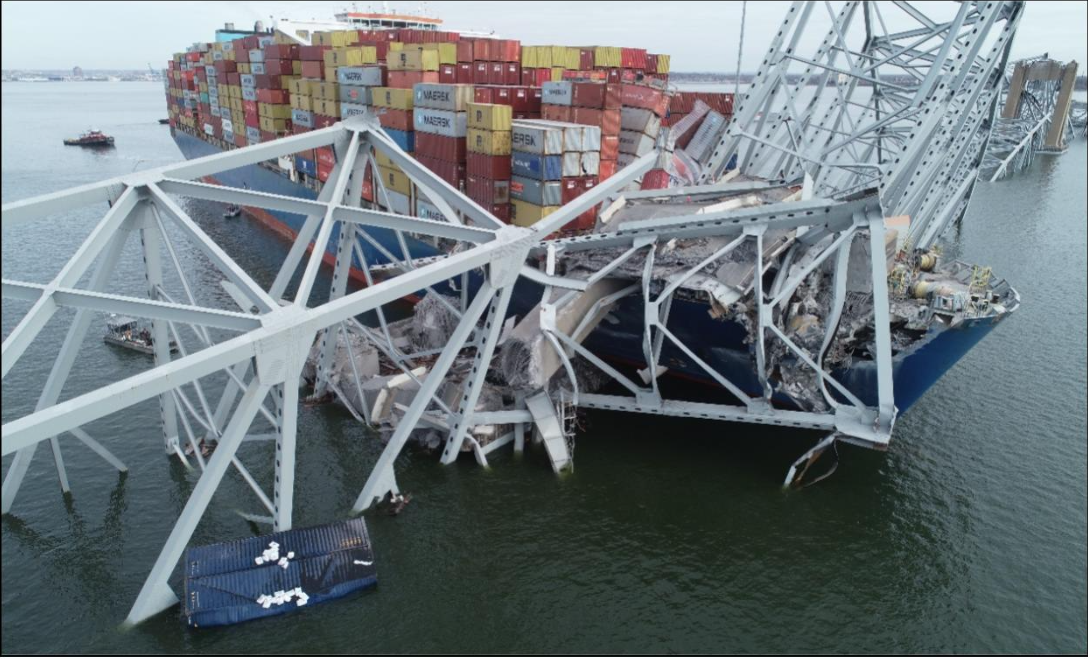By Michael Grey*

When something goes badly wrong, it is human nature to attempt to deflect the blame and to cite extenuating circumstances to explain away everything from why you took up a life of crime, to the reasons for driving at 50mph in a 20mph zone. It has become quite scientific these days, with a range of neuro-pathologies available to be cited and excuse the lapse. And it is much the same in the commercial world, with expert witnesses becoming far more expert in their abilities to fashion plausible reasons to explain why terrible accidents have occurred.
There is certainly plenty of technical expertise being summoned in the case of last year’s Baltimore Bridge disaster, as efforts are made to mitigate the doubtless eye-watering costs which clearly are heading towards the owners of the container ship Dali. It has been reported in Splash that as the accident has now been attributed to a fault in the vessel’s switchboard at the crucial moment, the owners are to sue the builders of the ship HD Hyundai for designing and installing defective equipment.
There now appears to be no further argument about what had happened, with a loose wire involved, but innumerable interests are already engaged in the search to attribute responsibility more precisely. The latest suit based on product liability laws is but one of many.
The ship was some nine years old at the time of the accident, so some might suggest that normal wear and tear might have been a contributor over the years in the robust maritime environment. If this a problem from the start, should not somebody have stepped in and fixed it? It will be interesting to explore just how many years can pass before such a claim for a deficiency will be dismissed. I can recall a case when a rudder fell off a 45-year old steamer in which the owners were inclined to claim that it was an intrinsic fault of the builders. Wiser counsels prevailed and it was eventually put down to old age and she was towed away for demolition.
Some witty person once pointed out that if you are looking for a decent guarantee on a product, you will get a longer lasting one for a toaster than an ocean-going ship.
My own friendly expert suggests that in the case of the Dali, it would be perhaps better to suggest that the port itself must attract some of the blame for not doing anything to reinforce the armour around the bridge supports, bearing in mind other similar crashes around the world, and the dimensions of ships using the port multiplying fivefold in the 50-year interval since its construction. Seaworthiness claims seem to become ever more complex. Is a ship unseaworthy if the officer of the watch falls asleep because of fatigue? You can reasonably argue that if the sleep-deficit is caused by operational requirements, or the fact that the hours anti-social and the officer’s cabin noisy, responsibility might be moved upstairs.
If containers fall over the side because the restraints were deficient, there is probably no argument. But was it damage or corrosion, or were the twistlocks just too weak for the job? There is plenty of scope for a diligent counsel. And where down the logistics chain does the blame for an electric car fire that destroys a big car carrier lie? Interesting to see that Matson Line is no longer to carry EVs and hybrids on ships. Or a container that unexpectedly overheats and explodes causing terrible damage to ship and the environment- who should ultimately pay for that? There are huge sums at stake here. X-Press Feeders whose ship burned out and caused great environmental harm in the Indian Ocean, is looking at a $1billion claim from Sri Lanka’s government.
Surely, one might think that the owners had very reasonable defence in the fact that the master of the ship was refused refuge in two ports after a leak in the hazardous cargo stack was identified. The cargo owners, those who stuffed the containers, the planners, and indeed those who refused to let the ship into their ports to sort out the problem before it became a crisis all surely ought to be looking to their legal defences. There will be years of lucrative work for the lawyers in such tangled cases That old rhyme about the horseshoe nail comes to mind.
(NTSB photo of Dali collision with Baltimore Bridge)
*Michael Grey is former editor of Lloyd’s List. This column is published with the kind permission of The Maritime Advocate.


